A Sinhalese Palm-Leaf Book in Deconstructed and Reconstructed Order
April 8, 2021 in Manuscript Studies
A Sinhalese Palm-Leaf Book
with Chopped and Disordered Leaves
A Cautionary Tale
Recently, we were contacted by a private collector, reading our blogposts and wondering about a book which had come through inheritance, without any identification to speak of. The bare bones of information relayed got the object indicated “that it is a Buddhist book, with handwritten pages of about 33 leaves written on both sides”. But what language? Is it manuscript or print? Etc.?
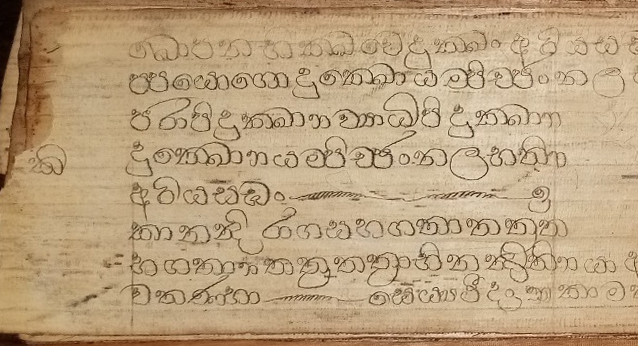
Private Collection, Sinhalese Palm-Leaf Manuscript, End-Leaf 01, Left.
A few photographs gave some first glimpses. (See below.) With them, we conferred among ourselves, and offered a preliminary description. It includes a brief guide about how to proceed, if wished, to examine the artefact more closely.
Mind you, we are talking in a time of pandemic and Bibliographical Lockdown. (See, with some observations about escape routes, Selbold Cartulary Fragments, including some resourceful tips. Summed up as: “When all else fails, read the text.”)
Images are an amazing resource, of course, but what photographs might we seek to take, and how to look at them? That question might come to the fore if, perchance, you don’t know what sort of book it is, let alone what language? What if you can’t read the text? And which way is up?
I phrase the questions this way because, in part, I can’t (yet) read every language (Can Dream!), decipher every script, etc., etc.
Perhaps you too?
Willing to learn? At least some rudiments appropriate for the particular artefact? Yes?
Read On!
Welcome
For this particular book, some of us in conversation find that the process of consultation, exchanging information, asking questions about the materials, offering suggestions for further exploration, and so on in an enriching cycle, might be useful also more widely. For example, outside of specialists, or those with ready access to them, what if we encounter materials in a format, language, script, and context not readily familiar?
Are you curious? Might you be willing to learn? Would you like to join our conversation?
So, this post is an experiment. Will it work?
Step 1: Preliminary Description
We provide a beginner’s guide for navigating the sequence of the leaves, without (yet) knowing the language and the script. Apparently the guide has some use in introducing the subject, explaining some of the challenges, and giving directions, with links to explore, for better understanding the nature of the book, both as it arrived in disordered sequence, and as it can be reconstructed.
This exploration forms a follow-up to
- Our gallery of selected Sanskrit and Prakrit Manuscripts, including specimens of palm-leaf books.
- the Booklet by our Associate David W. Sorenson, An Introduction to Indian Manuscripts for the Non-Specialist, prepared for our 2020 Symposium.
It is not known when or where the present case was acquired. Now, in its present Private Collection, it offers a case-study. We thank the owner for permission to present the leaves to you, as we wonder about the structure of their original manuscript.
The First Glimpses
We first saw these photographs.
Beveled Cover, Knotted Stringing Cord Included
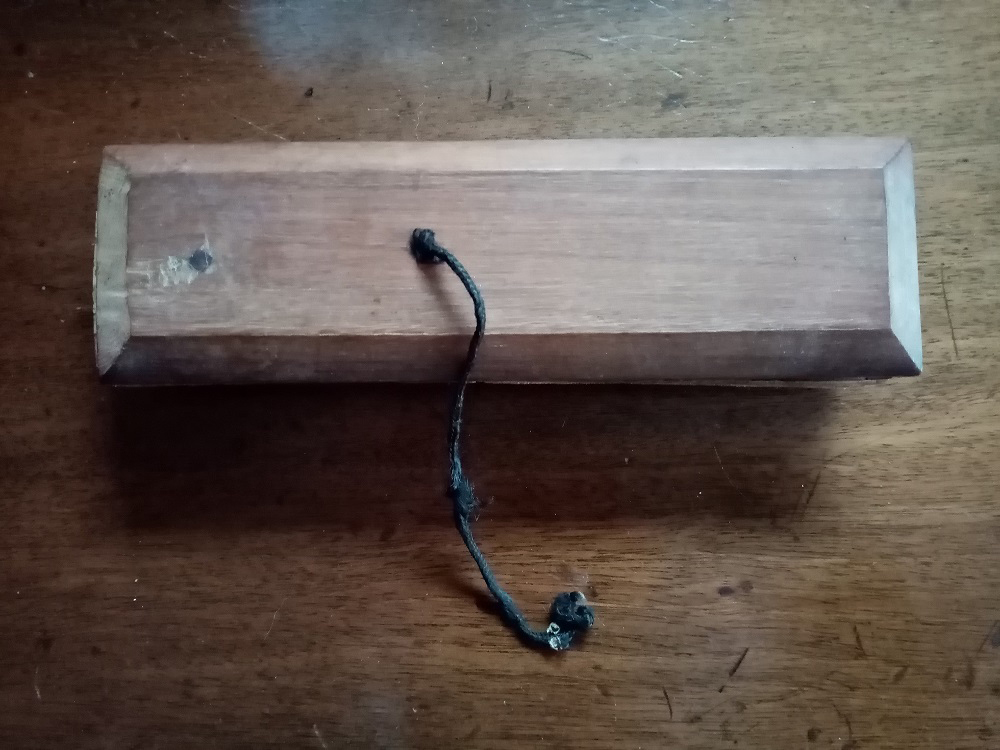
Private Collection, Sinhalese Palm-Leaf Manuscript, Cover.
An Opening (Photo ‘blade-01’)

blade-01
An End Leaf (Photo ’01-a’)
At one end of the bound book:

Private Collection, Sinhalese Palm-Leaf Manuscript, End Leaf ’01a’.
Another End Leaf (’01b’)
At the other end:
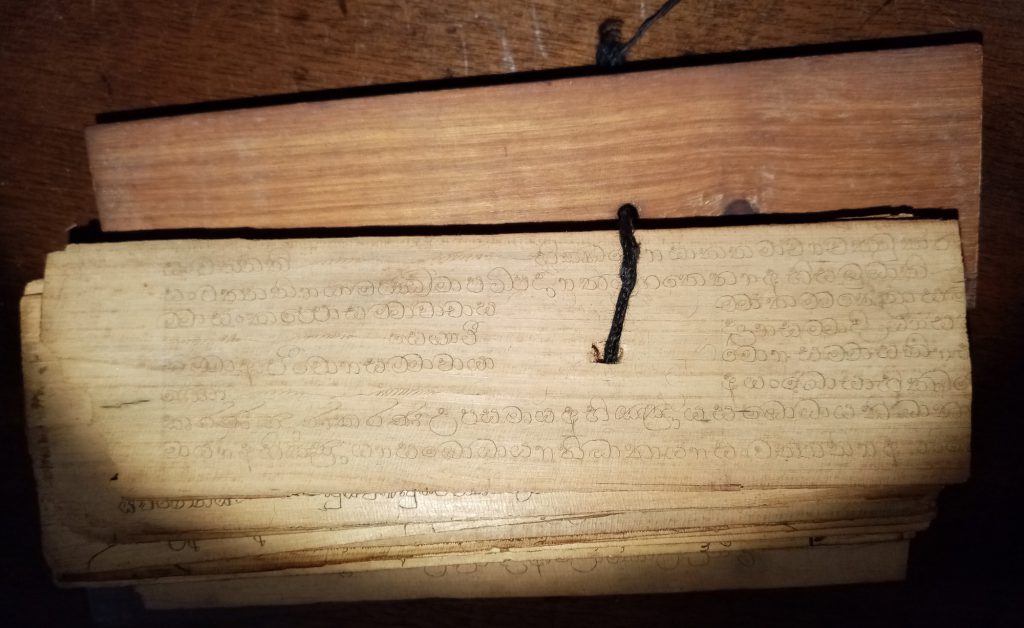
Private Collection, Sinhalese Palm-Leaf Manuscript, End-Leaf. ‘For-bag 01b’
The Ensemble
Already with these images, it could be seen that the palm-leaf manuscript is written in Sinhalese script (Sinhala_script). The material is palm-leaf, and the book is a manuscript, not a printed text. As it stands, the leaves of the ensemble are strung on string or cord through a single stringing hole, ending in a simple beveled rectangular cover.
A match for the specimen in terms of script appears here, with transliteration of its text:
Considering the text and script, we now orient the images to show their script standing upright. For example:
Opening (Photo ‘blade-01’ upright)
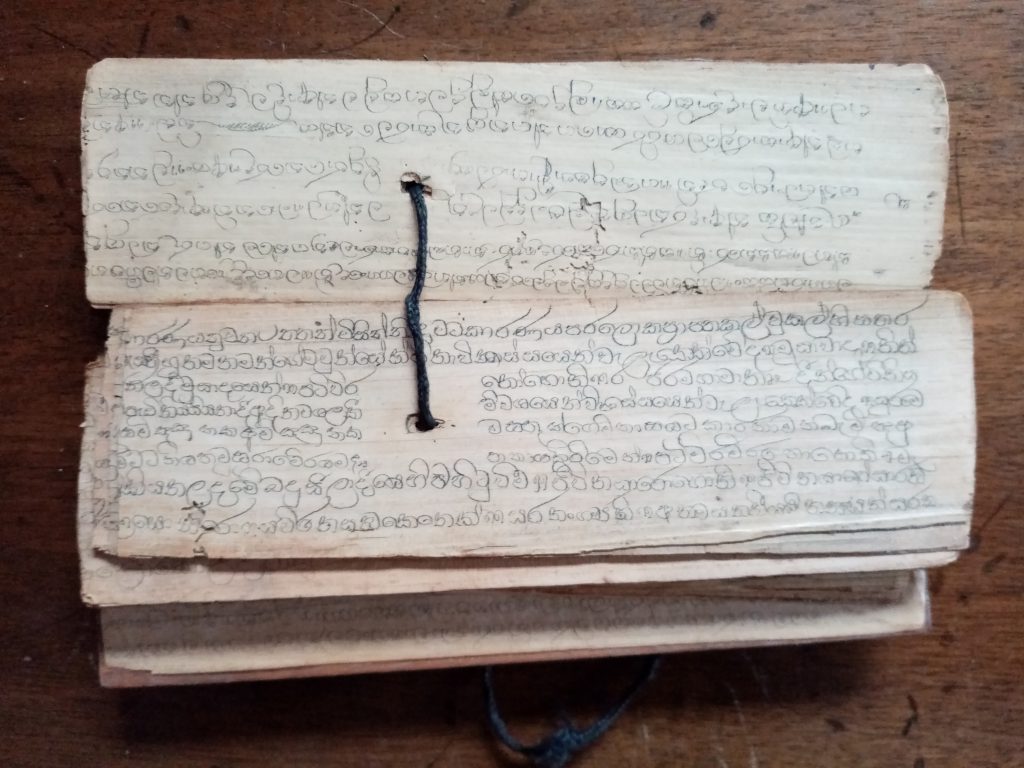
Private Collection, Sinhalese Palm-Leaf Manuscript, Opened.
The language is mostly likely Pali (a guide: Pali). A Middle Indo-Aryan liturgical language, it is native to the Indian subcontinent.
The text is a Buddhist treatise of some sort, but without seeing the last leaf of the original with its expected colophon, we cannot readily tell the title.
The Order As Restructured, or ‘Repackaged’
Unfortunately the entire manuscript has been cut in half vertically, yielding halves of pages/leaves. They have been strung together in some order or other. (To be determined.)
The plain beveled board cover at one end (shown above) corresponds to the reduced size, so it is a subsequent addition to the original production and intention of the book.
Each page retains only one outer margin and only a single stringing hole, rather than the original pair of holes and of outer margins.
A typical example, from a manuscript of the Vessantarajataka Jātaka in another private collection, shows the full span of the leaves, with double stringing holes and both margins. The following image shows its cover and some leaves outspread. Here, one string laces through one of the double holes in each leaf, while the other hole, now unlaced, is left free, allowing the leaves to fan outward for a broader view.

Private Collection, Vessantara jataka Manuscript.
The sample images of the Sinhalese palm-leaf case, as sent to us, indicate that both upper and lower margins survive at least in part, so that the number of lines per page would be original. Note that the number of lines per page shows some variation — as seen in image entitled”blade-01″, with one leaf facing another having 8 and 6 lines respectively.

blade-01
The manuscript may be complete, albeit cut in half to look like twice the number of leaves which it had originally. It is uncertain in what order the reduced leaves stand.
Leaf Numbers
The leaf-numbers appear on the left end of the verso of each leaf. On Photo ‘for-bag-01a’ (turned upright), the “letter-number” appears at the left side, hence it’s the verso. The “numbers” are the letters with vowel-markings, from ‘Ka’ (ඛ) onward in the traditional order.

Private Collection, Sinhalese Palm-Leaf Manuscript, End Leaf ’01a’.
On this system of numbering, see Sinhala Numerals. Among them, the Kaṭapayādi or Katapayadi System uses Sinhala consonants to depict Numbers 1 to 9 and 0, “for easy remembrance of numbers as words or verses”. The numeration “is known as Katapayadiya since number one is allocated with the Sinhala letters ‘Ka’ (ක), ‘Ta’ (ට), ‘Pa’ (ප ) and ‘Ya’ (ය)”.

Private Collection, Sinhalese Palm-Leaf Manuscript, End-Leaf 01, Left.
Detailed study might reveal what parts of the original remain, and in which order they are assembled.
Unfortunately such alterations for the market are not rare nowadays.
The Order, Now and Then and Again
Which is front and which is back of the book? For the novice, we suggest:
You could try the following.
1. Start with the closed book, lengthways in front of you on a flat surface, with the cover facing up.
2. Open the cover away from you, turn it over, and put it down, with the inside cover upward, beyond the first leaf (‘leaf_a‘) which stands on top of its followers in the text-block.
As with End-Leaf ‘For-bag 01b’:

Private Collection, Sinhalese Palm-Leaf Manuscript, End-Leaf. ‘For-bag 01b’
3. If the script on the leaf is the right way up (as shown, for example, in Sinala Script), go to step 4.
If it is upside-down, close the book, turn it 180 degrees on the table, and open it again.
The script should be the right way up. Like this:

Private Collection, Sinhalese Palm-Leaf Manuscript, End Leaf ’01a’.
4. Turn the first leaf (leaf_a) and place it on top of the cover, showing the back of the leaf. The script on the next leaf (‘leaf_b‘) should also be the right way up.
If it isn’t, some leaves must have been turned around, and we can’t tell much of anything until we can read the text.
5. Look at the script on the back of leaf_a. If it is the right way up, then this is the Front of the Book.
6. If it is upside-down, close the book, turn it over, and repeat steps 1 through 5. If this is now the front, you have the answer. If it also looks like a Back, then it would be necessary to decipher the text.
On account of the bisection of the leaves, the position of the margin upon an upright page, at the left or at the right, would indicate to which side of the original leaf this page/leaf belonged.
It could be possible to discern which ‘half-leaves’ belong to each other, and then notionally join up the severed lines of script on their rectos and versos.
Towards Reconstruction
Although such observations can be painstaking, we have become accustomed to such lengths which the fragmentation and rearrangement of original manuscripts might demand of research and reconstruction. Our blog on Manuscript Studies tells their stories. See its Contents List.
We thanked the collector for showing us glimpses of the book. We asked “How long have you had it, and how did it come to you?”
There returned a full set of photographs, with permission to publish them here, so that we might all join in the process of deciphering the series of leaves and discerning their original sequence. Would you like to join in?
The Disordered Sequence at Present
The photographs as sent start at one end of the book and progress consecutively through it. Each image includes a paper slip carrying the arabic numeral of the leaf (1–33), with the added suffix ‘A’ to indicate the other side of the same leaf. The slip stands outside the designated leaf, but remains clearly in view. For certain purposes, we might crop the identifier from the image, so as to focus upon the leaf itself. For now, because of the disordered sequence of the half-leaves, and the condition which we face at present of viewing them through photographs, it seems prudent to show the images as they come, with the clearly marked identifiers recording the place in the ensemble.
Side 1, with Letter/Number KA (“1)
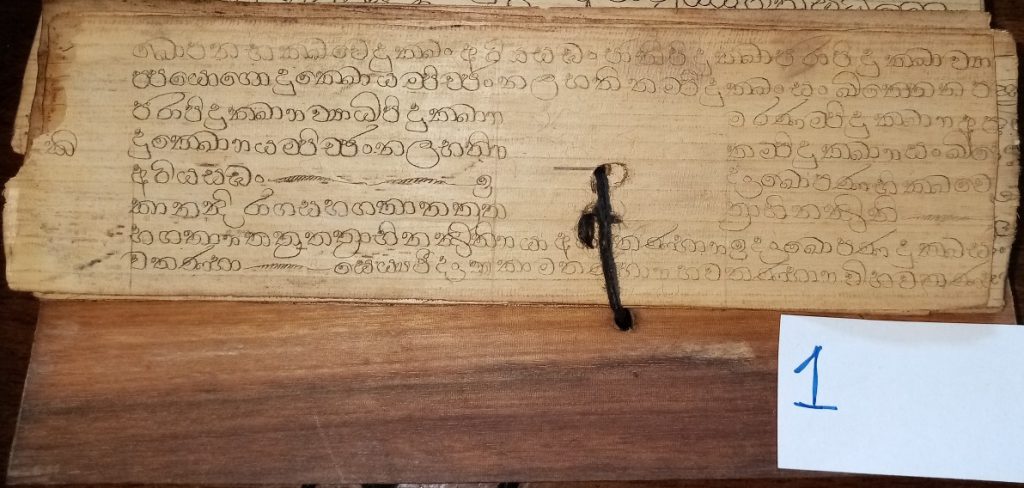
Private Collection, Sinhalese Palm-Leaf Manuscript, End Leaf ’01a’ =Side 1 with letter/number KA.
Side 1A
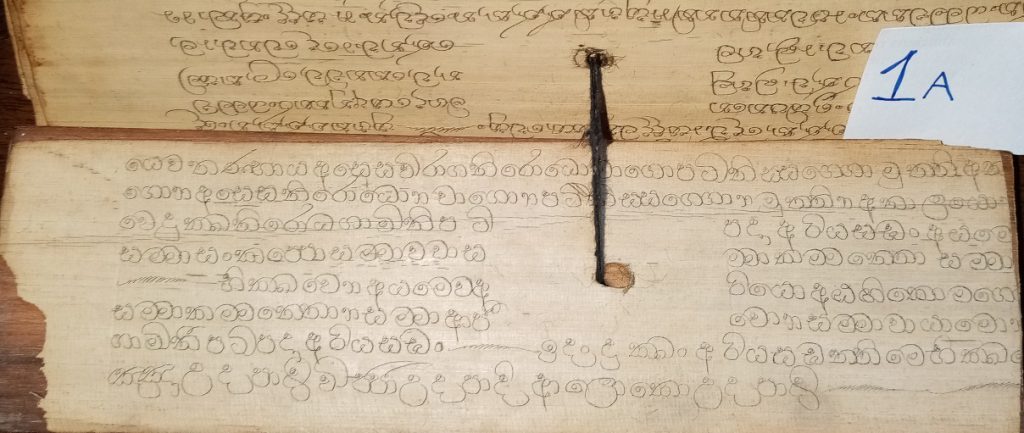
Private Collection, Sinhalese Palm-Leaf Manuscript, Leaf ’01a’ / 1A.
Side 2

Private Collection, Sinhalese Palm-Leaf Manuscript, Leaf ’02’ / 2 (Text Inverted).
Side 2A

Private Collection, Sinhalese Palm-Leaf Manuscript, Leaf 2A (Text Inverted).
Side 3

Private Collection, Sinhalese Palm-Leaf Manuscript, Leaf ’03’, Side 1.
Side 3A, with Letter/Number Mark

Private Collection, Sinhalese Palm-Leaf Manuscript, Leaf 3A.
Side 4

Private Collection, Sinhalese Palm-Leaf Manuscript, Leaf 4.
Side 4A, with Letter/Number Mark

Private Collection, Sinhalese Palm-Leaf Manuscript, Leaf 4, Side A.
Side 5

Private Collection, Sinhalese Palm-Leaf Manuscript, Leaf 5 Reproduced by Permission.
Side 5A, with Letter/Number Mark

Private Collection, Sinhalese Palm-Leaf Manuscript, Leaf 5, Side A. Reproduced by Permission.
Side 6

Private Collection, Sinhalese Palm-Leaf Manuscript, Leaf 6. Reproduced by Permission.
Side 6A, with Letter/Number Mark

Private Collection, Sinhalese Palm-Leaf Manuscript, Leaf 5, Side A. Reproduced by Permission.
Side 7

Private Collection, Sinhalese Palm-Leaf Manuscript, Leaf 7. Reproduced by Permission.
Side 7A, with Letter/Number Mark

Private Collection, Sinhalese Palm-Leaf Manuscript, Leaf 5, Side A. Reproduced by Permission.
Side 8

Private Collection, Sinhalese Palm-Leaf Manuscript, Leaf 8. Reproduced by Permission.
Side 8A, with Letter/Number Mark

Private Collection, Sinhalese Palm-Leaf Manuscript, Leaf 8, Side A. Reproduced by Permission.
Sides 9–11A. See Below.
[Etc. More to come.]
*****
Another post will offer more images from the manuscript. Here, we pause to show a set of images, in reconstructed order, that demonstrate the original structure of original leaves, or clear the path toward that goal.
Steps Toward Reconstruction
Material and textual evidence, in combination, permits a virtual reconstruction of the former leaves and their sequence in the manuscript. Examining the photographs one by one, we can group the half-leaves by distinguishing features, as Left-Hand or Right-Hand Segment (‘Half-Leaf’), Text Upside-Down or Upright, Number of Lines per Column, Letter/Number marks where present, matching features along the vertical line of division between halves of a leaf, and so on. Columns with 5, 6 7, or 8 lines respectively offer a ready starting point for correlations.
Unusual features leap to the forefront. They offer ready pointers for lining up some disjointed parts.
Doubled Stringing Holes
For example, a few half-leaves have doubled pairs of stringing holes, with a smaller second hole alongside a disused circular hole. Some of the doubled pairs occur on Sides 9–11A and 22–24A, as the images make clear. We show them here.
There may be others, perhaps partly obscured in the images, under the current string (as with Sides 28A, 29A, 30A).
Some other half-leaves have piercings, or pointed indentations, alongside the original hole (which remains in use in the stringing). Those features manifest the incomplete attempts at forming a second hole slightly distant from it, or else the effects of such attempts impacting partway into them as they lay at a lower place in the stack.
Such effects appear, for example, on Sides 13–13A, 26–26A, and 27–27A. Those and other half-leaves are displayed in Part 2 of our Posts on this Manuscript. (See below.)
The doubled holes must derive from the stage of cutting the original leaves of the manuscript into half-leaves, and forcing those halves into an approximate alignment with other leaves for re-stringing on a single hole to form a semblance of a book.
Side 9 (= Right-hand Half)

Private Collection, Sinhalese Palm-Leaf Manuscript, Leaf ’09’, Side 1 (Text Upright).
Side 9A
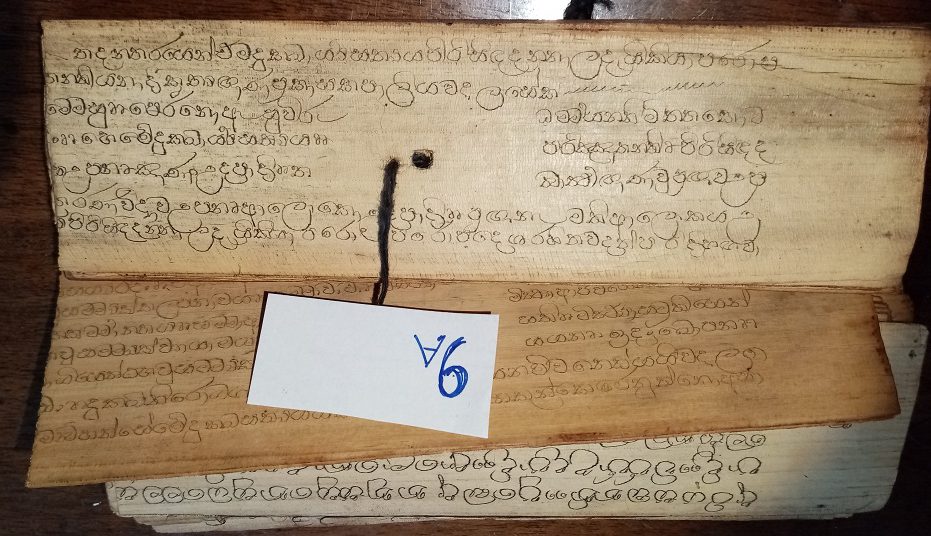
Private Collection, Sinhalese Palm-Leaf Manuscript, Leaf 9A (Text Upright).
Side 10
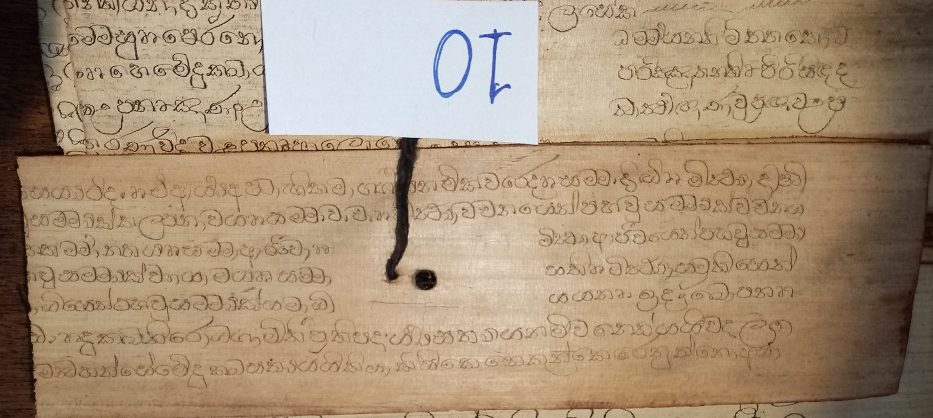
Private Collection, Sinhalese Palm-Leaf Manuscript, Leaf ’10’, Side 1 (Text Upright).
Side 10A
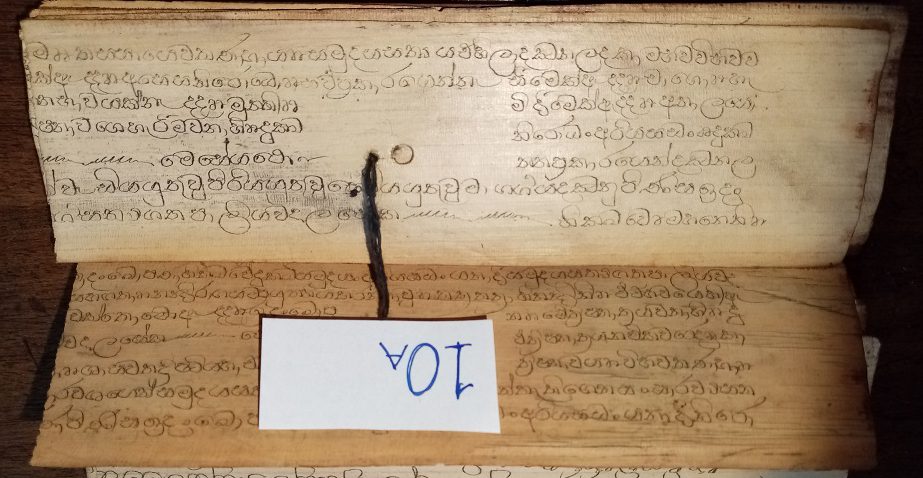
Private Collection, Sinhalese Palm-Leaf Manuscript, Leaf ’10’, Side A (Text Upright).
Side 11

Private Collection, Sinhalese Palm-Leaf Manuscript, Leaf ’11’, Side 1. (Text Upright.) Reproduced by Permission.
Side 11A
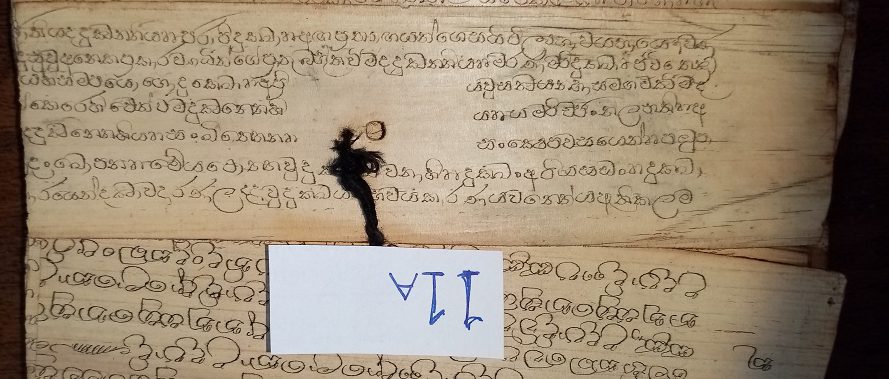
Private Collection, Sinhalese Palm-Leaf Manuscript, Leaf ’11’, Side A. (Text Upright.) Reproduced by Permission.
Side 22

Private Collection, Sinhalese Palm-Leaf Manuscript, Leaf ’22’, Side 1. Reproduced by Permission.
Side 22A

Private Collection, Sinhalese Palm-Leaf Manuscript, Leaf ’22’, Side A. Reproduced by Permission.
Side 23
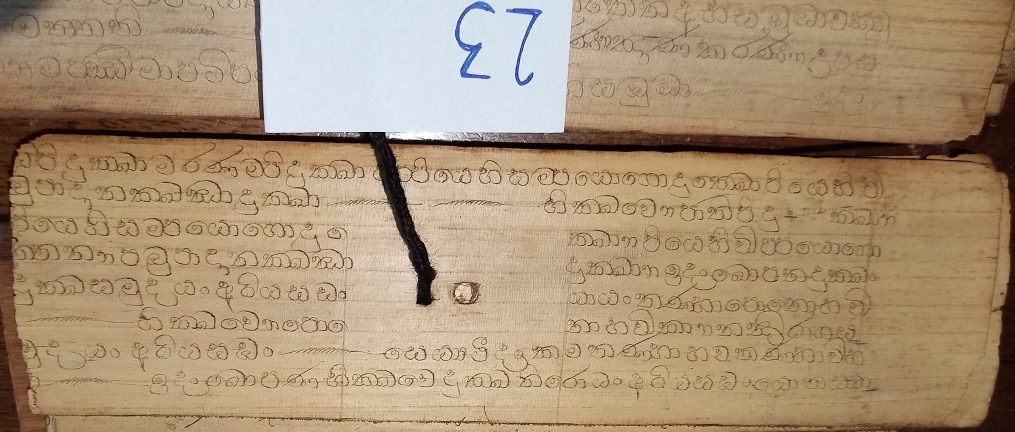
Private Collection, Sinhalese Palm-Leaf Manuscript, Leaf 22, Side 1 (Text Upright). Reproduced by Permission.
Side 23A
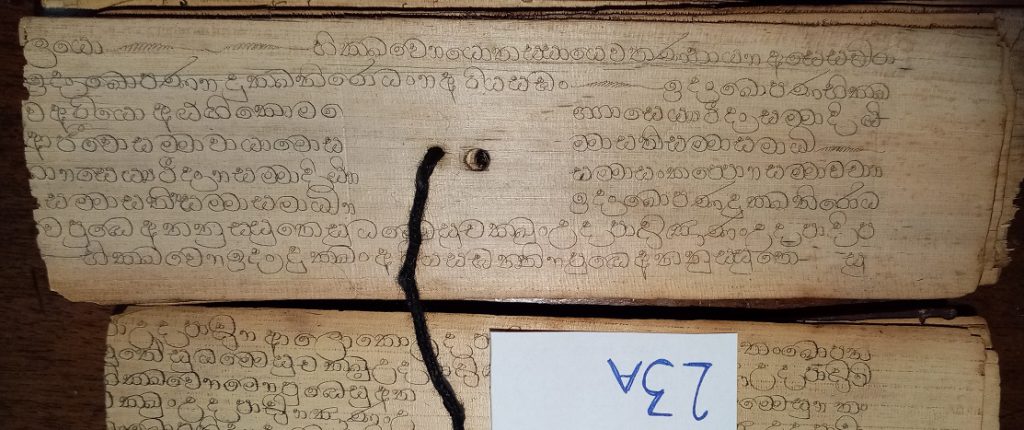
Private Collection, Sinhalese Palm-Leaf Manuscript, Leaf 22, Side A (Text Upright). Reproduced by Permission.
Side 24
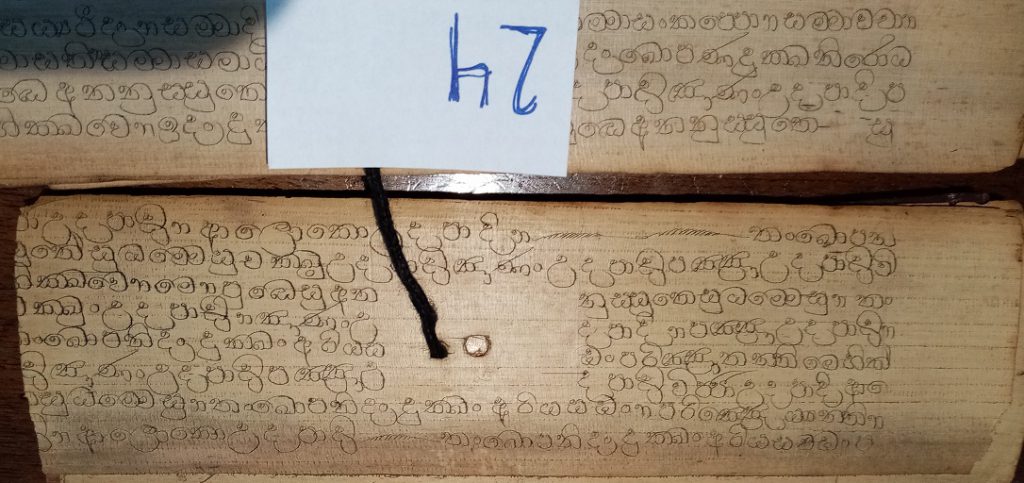
Private Collection, Sinhalese Palm-Leaf Manuscript, Leaf 24, Side 1 (Text Upright). Reproduced by Permission.
Side 24A

Private Collection, Sinhalese Palm-Leaf Manuscript, Leaf 24, Side A (Text Upright). Reproduced by Permission.
Idiosyncratic Line-Spacings as a Case in Point
A group of closely-spaced lines at the bottom of one column indicate a clear match between a left-hand half and a right-hand half of one former conjoined side of a leaf.

Private Collection, Sinhalese Palm-Leaf Manuscript, Reconstructed View of Former Leaf (’30A’ + 26A’).
Their opposite sides will form another conjoined pair, to complete the virtual reconstruction of the leaf in full.
More Link-Ups Await within the Fragment
There remain more connections to discern between the half-leaves as repackaged and assembled into some sort of sequence. We begin that process, as you see, and we open the way for you to join the quest, if you wish.
Note that the ensemble as transmitted apparently does not retain all the leaves from the original. The uneven number of leaves, or rather half-leaves of the former wholes, guarantees that at least one half-leaf was not included in the re-stringing of the deconstructed ensemble. An expected colophon is absent.
The aim of this post is to demonstrate a case, alas among many, whereby a market might take advantage of visitors or tourists wishing for a souvenir (genuine) of a visit to a foreign and fascinating land. We do not know if such an occasion provided the means by which this rearranged palm-leaf manuscript was acquired by the owner from whom the present owner received it. Suffice to say that such occasions can provide the pathway, and, for sellers and despoilers, the incentive.
Say a visitor to somewhere in South Asia, admiring of the culture, but unknowing the language(s), might wish to have a palm-leaf book, ready-made. In time, imported to Western lands, there might arise wonder about the artefact.
This is the story, in outline, of the Sinhalese Palm-Leaf Manuscript we examine here.
The guides aim to offer beginners, inexperienced with the relevant scripts and texts, a willing way to begin to approach an understanding of how such an artefact might work.
Verily, a Cautionary Tale.
We hope that you might recognize the signs of a disordered souvenir presented in the form of a purported palm-leaf manuscript book. Palm-leaf, and manuscript, it might be. But in what shape? Buyer, beware, and Buyer, be aware.
Best wishes!
*****
We warmly thank the owner for contacting us, for sending sample photographs, for sending a fuller set of photographs (moreover clearly marked by sequentially numbered cards in frame!), and for joining enthusiastically in the quest to ‘decipher’ the manuscript, and to learn more about it. We are grateful for permission to show the photographs and to invite your help in this quest.
*****
Might you please identify the text? Do you know where other leaves from this book, including the opening and closing leaves, might survive?
Do you recognize the work of the scribe(s) in other manuscripts? Do you have advice about its dating and origin?
For those with expertise in these manuscripts, this script, and this text, please don’t mind our wish to learn more.
Please let us know. We invite you to place your Comments here, Contact Us, and visit our Facebook Page.
Next stop: More Leaves from this Book.
See: More Leaves from a Deconstructed Sinhalese Palm-Leaf Manuscript.

Private Collection, Sinhalese Palm-Leaf Manuscript, End-Leaf 01, Left.
*****

Leaf 23a contains part of discourse called Mahāli-Sutta from the Dīghanikāya, the basket of the the long discourses (canonical text of the Theravāda Buddhists). The language is Pāli.
Many thanks for your identification of the text and language. We are grateful for your help. Best wishes!